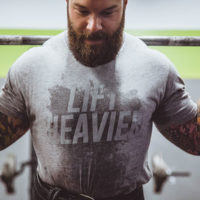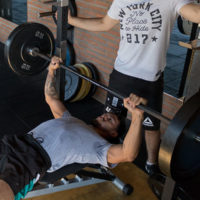With an array of implements to use, Hall of Fame Powerlifter Brad Gillingham shares why he loves the kettlebell.
The kettlebell is a versatile piece of equipment that would be a great addition to anybody’s strength training arsenal. The kettlebell is a round shaped weight that resembles a cannon ball with a handle. Twenty years ago, it was impossible to find a kettlebell in any gym, but today most gyms have a large selection. Kettlebells ranging from 25 lbs. to 50 lbs. seem to be the most popular, but kettlebells are available from 9 lbs. all the way up to a whopping 203 lbs. I have never tried to tackle the 203 lb. kettlebell, but on occasion we will swing 130 lbs. at the gym. Some of the most prevalent kettlebell exercises include swings, pressing movements, cleans and snatches, goblet squats, single leg deadlifts, and Turkish get-ups. This article will focus on the kettlebell swing.
History of Kettlebells
Kettlebells have a history dating back to ancient Greece. Ultimately kettlebells became popular in Germany and Russia, and started to be used for conditioning and sport.1 I personally learned about kettlebell training from reading articles in MILO Magazine, and Powerlifting USA about Belarusian Strength and Conditioning Guru, Pavel Tsatsouline. Pavel, a former trainer of Russian Special Forces, founded the Russian Kettlebell Certification (RKC) in the US in 2001.2 Years ago, I had a long conversation at an airport with Pavel regarding the benefit of kettlebell swings for rehabilitation of my lower back pain. After that conversation, I purchased several kettlebells and I was immediately sold on the benefits of kettlebell swings. I have since used kettlebell swings to warm-up, rehab my back, and increase hip extension strength.3 I can attest thatthe kettlebell swing was an instrumental exercise that I employed during my twenty-year journey towards (102) competition deadlifts over 800 lbs.
How to Perform the Kettlebell Swing
The basic kettlebell swing is performed by grabbing the handle of the kettlebell with both hands between your legs. The kettle bell is swung like a pendulum, using a hip hinge, with straight arms to eye level. This movement should emphasis explosive hip extension of the posterior chain. It will involve the hamstrings, glutes and lower back. At the top of the movement, you should be standing tall with the core contracted, and glutes squeezed. A big mistake is trying to complete the movement by lifting with the arms and shoulders. The kettlebell swing should only involve the upper body as a lever to support the movement. The main emphasis is on the posterior chain. Here is a demo video for reference.
Applications for the Kettlebell
The kettlebell swing is an exercise that I use both as a dynamic warm-up with lighter loads, and as a strength and power builder with heavier loads. I utilize a dynamic warm-up and mobility circuit with all of my athletes. I include kettlebell swings in this circuit with the primary purposes to activate the muscles of the posterior chain, and to reinforce the correct hip hinge movement pattern. Research indicates that the kettlebell swing creates a hip hinge movement with patterns of rapid muscle activation-relaxation cycles emphasizing the posterior chain3.
I use kettlebell exercises for strength and power development with various athletes ranging from volleyball players to wrestlers. The kettlebell swing is a great exercise to increase vertical jump. A six week study indicated that performing bi-weekly kettlebell swings resulted in a 9.8% increase in the half- squat, and a 19.8% increase in vertical jump height.4 In addition to the kettlebell swing, I frequently use the kettlebell for weighted jumps as part of a contrast training circuit. How does this apply to wrestlers? Vertical jumping ability is a great indicator of power output, and the ability to generate power and strong hips are essential for wrestlers.
Finally, research indicates that kettlebell swings may assist with restoring back health and function.3 The kettlebell swing has been a key component to keeping my lower back healthy. I generally stick to 3-5 sets of 10 repetitions. If I’m having a hard time warming up, I might even include some lighter kettlebell swings between working sets in both the squat and deadlift. In addition, I like to use heavier kettlebell swings as a finisher to back and leg workouts for glute and hip extension development. Strong glutes equal a healthy lower back. Good luck with your training and Stay Strong!
Brad Gillingham, myHMB athlete | CSCS
References:
- English, N. (2016, November 22). Kettlebell history goes back much further than Russia. https://barbend.com/kettlebell-history/
- Meigh NJ, Keogh JWL, Schram B, Hing WA. Kettlebell training in clinical practice: A scoping review. BMC Sports Sci Med Rehabil. 2019;11(19):1-30.
- McGill, S.M., & Marshall, L.W. Kettlebell swing, snatch and bottoms-up carry: Back and hip muscle activation, motion, and low back loads, Strength Cond Res. 2012;26(8): 16-27.
- Lake JP, Lauder MA. Kettlebell swing training improves maximal and explosive strength. J Strength Cond Res. 2012;26(8):2228-2233. doi:10.1519/JSC.0b013e31825c2c9b






